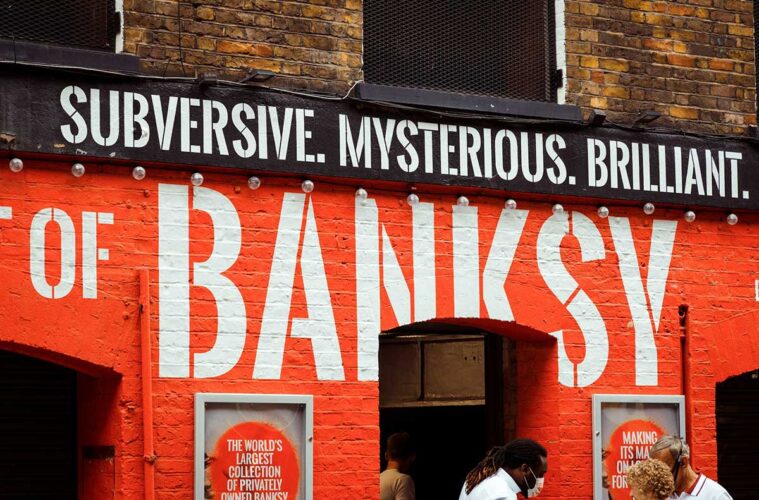Who Is Banksy? Unravelling the Enigma of the World’s Most Elusive Street Artist
Banksy is a name that resonates across the realms of contemporary art, culture, and political commentary. Although his identity remains shrouded in mystery, his work is unmistakable—a striking blend of dark humour, provocative messages, and ingenious use of public spaces. This article delves into the life, art, and legacy of Banksy, exploring the origins of his work, the evolution of his style, and the profound impact he has had on society.
The Origins of an Anonymous Icon
Banksy emerged from the underground street art scene of the late 20th century, a period marked by a burgeoning movement that sought to reclaim urban spaces and challenge the traditional art establishment. The artist’s early works appeared in the mid-1990s on the walls of Bristol, a city known for its vibrant cultural landscape. Drawing inspiration from a diverse range of influences—from the irreverent humour of graffiti to the raw, unfiltered reality of urban life—Banksy crafted images that were both visually arresting and intellectually provocative.
His early pieces often employed stencils—a technique that allowed for rapid deployment in public spaces while maintaining a consistent style. This method not only lent his art a distinctive, almost iconic quality, but also enabled him to create a body of work that could be reproduced quickly and with relative anonymity. Over time, Banksy’s work began to transcend the boundaries of street art, engaging with broader socio-political themes and capturing the attention of art enthusiasts and critics alike.
The Enigma of Anonymity
Perhaps the most fascinating aspect of Banksy’s persona is the mystery surrounding his true identity. Despite numerous attempts by journalists, art critics, and enthusiasts to unmask him, Banksy has managed to preserve his anonymity with remarkable precision. This deliberate concealment is not merely a tactic to avoid legal repercussions for unauthorised public art—it is a statement in itself. In a world where personal branding and celebrity often take centre stage, Banksy’s refusal to step into the limelight challenges the very notion of artistic fame.
The veil of secrecy adds an additional layer of intrigue to his work. Each new piece is imbued with the sense of a hidden truth, prompting viewers to ponder not just the imagery, but the identity and motives of the artist behind it. By remaining anonymous, Banksy invites the public to focus on the art rather than the personality, thereby shifting the conversation from who he is to what his work represents. This strategy has cemented his status as an icon of resistance against the commodification of art.
Artistic Style and Themes
Banksy’s work is characterised by its bold visual style and incisive commentary on modern society. His pieces often feature a blend of humour, irony, and poignant social critique, which is conveyed through simple yet powerful imagery. Here are some of the recurring themes in his oeuvre:
Political Activism: Many of Banksy’s works are overtly political. From images that critique war and militarism to pieces that address issues of capitalism and consumerism, his art serves as a mirror reflecting the societal ills of the modern age. The artwork “There Is Always Hope” and other pieces questioning authority and the status quo resonate deeply with audiences worldwide.
Social Commentary: Banksy’s art frequently touches upon themes of poverty, injustice, and the disparities between the rich and the poor. By placing his art in public spaces—often in the very heart of urban centres—he creates a direct dialogue with everyday citizens. His works remind us that art can be a powerful medium for addressing social issues, sparking discussions that might otherwise remain confined to academic or political spheres.
Humour and Satire: A distinctive element of Banksy’s style is his use of humour. His art often incorporates witty, satirical elements that serve to both entertain and challenge viewers. This blend of levity and critical commentary is one of the reasons his work is so accessible, appealing to a diverse audience that spans all ages and backgrounds.
Ephemeral and Site-Specific Works: Unlike traditional art that is confined to galleries and museums, Banksy’s work is transient. His pieces are frequently created on the fly in public spaces, subject to the elements and urban renewal. This impermanence is a critical aspect of his artistic message—highlighting the fleeting nature of both art and the issues it reflects. The temporary existence of his work underscores the urgency of the messages he conveys.
Cultural Impact and Legacy
Banksy’s influence extends far beyond the world of street art. His work has challenged conventional ideas about art’s role in society, questioning the exclusivity of galleries and the art market. By taking his creations directly to the public, Banksy democratises art and makes it accessible to everyone, regardless of social or economic background.
Mainstream Recognition and Market Phenomenon:
Despite his disdain for the commercialisation of art, Banksy’s works have commanded record-breaking sums at auction. This paradox—where art created as a form of protest becomes a coveted asset in the global market—sparks critical debate about the nature of art in the modern era. Critics argue that the commodification of Banksy’s work undermines its original message, while supporters contend that the high prices only serve to amplify the discussions around art and society.
Influence on Contemporary Artists:
Banksy has inspired a generation of artists to explore the boundaries of public art. His innovative use of stencils and his fearless engagement with controversial subjects have paved the way for new voices in the street art movement. Artists across the globe have adopted his techniques and themes, using art as a means of political and social expression. In doing so, Banksy has contributed to a vibrant, evolving art scene that continually challenges the norms of artistic creation.
Documentaries and Media Coverage:
The mysterious nature of Banksy’s identity and the provocative content of his work have made him a favourite subject for documentaries and media investigations. Films and television programmes have attempted to piece together the puzzle of his life, examining both his art and its broader implications. While many of these efforts have only deepened the mystery, they have also elevated Banksy’s status as a cultural phenomenon—a symbol of the power of art to inspire, challenge, and provoke.
Controversies and Criticisms
Like many influential figures, Banksy is not without his critics. His work, which often critiques authority and societal norms, has sometimes attracted negative attention from those who feel targeted by his messages. Some controversies surrounding his art include:
Legal and Ethical Questions:
The unauthorised nature of Banksy’s street art has led to legal disputes and debates over intellectual property rights. While many laud his defiance as a form of artistic liberation, others argue that vandalism—even when artistically valuable—can have detrimental effects on communities and urban environments.
The Paradox of Commercialisation:
As mentioned earlier, the commercial success of Banksy’s work presents a contradiction. Critics point out that the high auction prices and widespread media attention are at odds with the anti-establishment ethos that defines much of his art. This paradox has led to ongoing debates about whether the commodification of his work diminishes its political potency.
Appropriation and Reproduction:
The ease with which Banksy’s style can be imitated has raised concerns about the dilution of his original message. Many emerging artists have adopted similar techniques, leading to a proliferation of works that mimic his style. This raises questions about originality and the true essence of artistic expression in the age of digital reproduction and mass media.
The Enduring Mystery and Its Significance
The fact that Banksy’s true identity remains undisclosed is central to his mystique. This anonymity not only protects him from legal repercussions but also reinforces the idea that art should speak for itself, independent of the artist’s personal life. In a culture increasingly obsessed with celebrity, Banksy’s refusal to be defined by his persona challenges us to look beyond the superficial and engage with the art on its own merits.
This enigma has given rise to numerous theories and speculations, with some suggesting that Banksy could be a collective of artists rather than a single individual. While definitive evidence is unlikely to emerge, the mystery continues to fuel public interest and scholarly debate. It is this interplay of secrecy and revelation that has cemented Banksy’s status as a pivotal figure in modern art—a symbol of artistic defiance and the unyielding power of creative expression.
Banksy’s Legacy in a Changing World
In an era marked by rapid technological change, globalisation, and social upheaval, the work of Banksy remains remarkably relevant. His art challenges us to question the status quo, confront uncomfortable truths, and consider the role of art as a catalyst for social change. Whether through his incisive political commentary or his playful subversion of traditional art forms, Banksy’s work continues to resonate with audiences around the world.
Impact on Urban Landscapes:
Banksy’s interventions in urban spaces transform mundane cityscapes into canvasses for critical dialogue. His works provoke onlookers to re-evaluate the environments they inhabit, imbuing public spaces with a sense of collective identity and shared responsibility. In doing so, Banksy’s art serves as a reminder that cities are living, dynamic entities—capable of inspiring change through the power of creativity.
Inspiring Future Generations:
For budding artists and activists alike, Banksy’s legacy is a powerful testament to the impact of art as a form of resistance. His ability to merge visual beauty with socio-political commentary offers a blueprint for using creativity to address some of the most pressing issues of our time. As future generations grapple with challenges ranging from environmental degradation to social inequality, the spirit of Banksy’s work will undoubtedly continue to inspire innovative and transformative approaches.
Concluding Reflections
Banksy is more than just an artist; he is a cultural phenomenon who has redefined the boundaries of art and activism. Through his skilful blend of wit, critique, and visual artistry, he has left an indelible mark on both the art world and society at large. The mystery of his identity only serves to heighten the impact of his work, inviting us to focus on the powerful messages conveyed through his images.
In an age where the lines between art, politics, and public discourse are increasingly blurred, Banksy’s work stands as a beacon of creative defiance. His art compels us to question our assumptions, challenge the status quo, and consider the potential of public spaces as arenas for dialogue and change. While the man behind the mask remains unknown, the legacy of Banksy is unmistakably profound—a testament to the enduring power of art to both reflect and transform the world.
Ultimately, the story of Banksy is one of mystery, rebellion, and innovation. It is a story that reminds us that art is not confined to galleries or museums, but is alive in the streets, echoing the voices of those who dare to dream of a fairer, more just society. Whether you see his work as a brilliant stroke of creative genius or as a provocative challenge to conventional norms, there is no denying that Banksy has carved out a unique place in the annals of art history—a legacy that will continue to inspire debate, reflection, and, most importantly, change.


